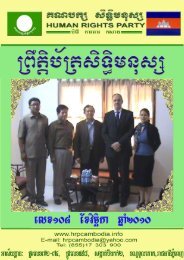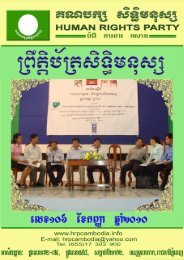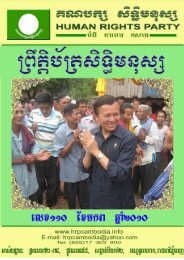Losing Ground - Human Rights Party.
Losing Ground - Human Rights Party.
Losing Ground - Human Rights Party.
You also want an ePaper? Increase the reach of your titles
YUMPU automatically turns print PDFs into web optimized ePapers that Google loves.
<strong>Losing</strong> <strong>Ground</strong><br />
Background to Siem Reap Crackdown<br />
The dispute over the high-yield rice fields escalated following<br />
the installation of water gates and the repair of a reservoir in<br />
2004-2005, but the conditions that fuelled it can be traced<br />
back to a dam built during the Khmer Rouge regime, the<br />
split of the commune around it, lack of land titles, and<br />
allegations of bribery, double standards, and mismanagement<br />
by government officials (at the commune, district and<br />
provincial levels) in the privatization of the reservoir and the<br />
land surrounding it once it soared it value.<br />
The 175 families from four villages in Chi Kraeng commune<br />
began clearing and cultivating the land below Sung Dam/78<br />
reservoir in 1981, though rice yields were low due to the<br />
lack of water.<br />
In 1986, the commune (which had 28 villages) was split<br />
into two: Chi Kraeng and Anong Samnor, with Chi Kraeng<br />
River serving as the natural boundary of the two (Chi<br />
Kraeng commune is west of the river and Anong Samnor is<br />
east of it). Although the disputed land is in Anong Samnor<br />
commune, farmers from four villages in Chi Kraeng who<br />
cleared it continued to farm it without opposition for more<br />
than a decade after the commune was divided.<br />
They say they have used it (for gathering firewood, fishing<br />
in ponds and farming) for generations, though – as is common<br />
in rural Cambodia – they lack land receipts or titles to the<br />
land. Following the split of the commune, residents and<br />
local officials in Anong Samnor commune made no attempt<br />
to obtain titles to it because rice yields were low.<br />
In 2004, the Chi Kraeng farmers postponed cultivation<br />
to work on a water gate that would flow water from the<br />
reservoir to 92 hectares. Prior to building the canal, on April<br />
16, 2004, they requested permission (from the provincial<br />
agricultural department via the district agriculture office) to<br />
build the water gate but received no reply. They proceeded<br />
anyway.<br />
At the end of the year, 42 families from Trapaing Tros<br />
village in Anong Samnor claimed that the 475 hectares were<br />
theirs. District and provincial authorities subsequently asked<br />
the Chi Kraeng farmers to stop farming on the disputed<br />
land until the dispute was resolved. The Chi Kraeng farmers<br />
agreed to this request.<br />
However, while the Chi Kraeng farmers were awaiting<br />
a resolution, three businessmen allegedly hired residents<br />
of Anong Samnor to install a canal from the reservoir, and<br />
on February 21, 2006 they were granted ownership of the<br />
canal used to flow water into the fields cleared by the Chi<br />
Kraeng farmers. During this time, farmers from Anong<br />
Samnor were permitted to farm the land, despite the fact<br />
that ownership of it was disputed.<br />
<strong>Human</strong> rights investigators allege that the Anong Samnor<br />
farmers include relatives of the canal owners, who are in<br />
turn linked to district and provincial officials. Moreover,<br />
the owners of the water gate sold land to farmers and<br />
officials from outside the district (for up to $1,600 per<br />
hectare), including residents of Siem Reap town, according<br />
to documents obtained by human rights investigators. These<br />
sales were not authorized by local authorities, investigators<br />
say. Some farmers from Anong Samnor have said they bought<br />
plots of land from the canal owners.<br />
The dispute went national in 2006 when the Chi Kraeng<br />
farmers submitted a complaint on behalf of 1,347 families<br />
to the Cabinet of Prime Minister Hun Sen: 175 families<br />
complained about alleged land grabbing, while 1,172<br />
families from Anong Samnor commune complained that<br />
public water was being embezzled from the reservoir. When<br />
ownership of the canal was transferred to the businessmen,<br />
communities who had used the reservoir were denied access<br />
to it or were charged fees (buckets of rice) in exchange for<br />
water. The complaint was written with the assistance of a<br />
reporter with Sangkum Khmer newspaper. Subsequently, a<br />
letter was sent from the prime minister’s office to resolve the<br />
dispute peacefully and quickly. This was followed by a letter<br />
from the provincial governor to the district chief asking him<br />
to solve the dispute. No action was taken, residents said.<br />
In 2007, the reporter submitted another complaint on<br />
behalf of the 1,347 families to the National Assembly and<br />
the Ministry of Interior which subsequently sent a letter to<br />
provincial officials asking them to resolve the dispute. No<br />
action was taken.<br />
In November 2008, the reporter submitted another<br />
complaint to the National Assembly and the ministry seeking<br />
their intervention on behalf of the Chi Kraeng farmers.<br />
<strong>Rights</strong> investigators quote the reporter as saying that in<br />
response to this complaint two letter were sent from the<br />
National Assembly: one to the 175 farming families granting<br />
them the right to cultivate the 475 hectares, and another<br />
to provincial authorities. The reporter is quoted as saying<br />
in reports as saying that the “carefully worded” letter to<br />
local authorities does not tell them exactly what to do<br />
but encourages them to resolve the dispute quickly and<br />
peacefully.<br />
72 Forced Evictions and State Intimidation in Cambodia






